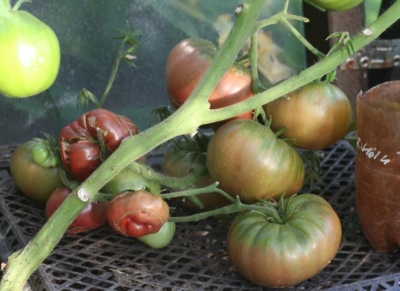
- Authors: Andreeva E.N., Sysina E.A., Nazina S.L., Bogdanov K.B., Ushakova M.I.
- Year of approval: 2000
- Category: grade
- Growth type: indeterminate
- Appointment: fresh consumption
- Ripening period: mid-season
- Ripening time, days: 115
- Growing conditions: for open ground, for film greenhouses
- Marketability: high
- Bush size: tall
Choke tomatoes are represented by varieties of all kinds of shapes, shades and sizes. The Black Elephant tomato, popular in Russia, is distinguished by its original color and impressive dimensions, which is why it got its name.
Breeding history
An application for registration of the Black Elephant variety was submitted to the State Register in 1998 by the Moscow selection and horticultural firm Gisok LLC. The authors of the novelty were breeders: Andreeva E. N., Nazina S. L., Sysina E. A. and a number of others. The originator is the TomAgros company. In 2000, after testing, the variety was approved and recommended for cultivation in almost all regions of the Russian Federation: from the North-West to the East Siberian.
Description of the variety
The black elephant is a fruitful mid-season variety with tall (160-180 cm) semi-spreading bushes of an indeterminate type, large leaves, similar to potatoes, and large flat-round brown-black fruits weighing 185-350 g. It is grown in open and protected ground.
The main qualities of the fruit
An unusual appearance is not the only advantage of black-fruited tomatoes: these varieties contain anthocyanins, which color vegetables in a dark color and have a number of beneficial properties for humans. The fruits of the Black Elephant belong to the beef class - they are fleshy, flat-round, weighty tomatoes. Unripe tomatoes have a dark green spot at the stalk, and over time they are filled with rich shades of burgundy, turning into black-brown. A brownish-green spot often remains on the "shoulders" of a tomato. Squat, flattened fruits are distinguished by ribbing: from weak to pronounced.
The average weight of Black Elephant tomatoes is about 200 g, but can reach 350-400 g. The fruits have a dense skin and juicy, fleshy dark red flesh with green seed chambers. The variety is transported well, but its keeping quality is short: 1-1.5 weeks.
Taste characteristics
The black elephant, like many "black" varieties, has an excellent taste. The increased sugar content is harmoniously combined with a slight sourness and astringency. Sometimes the taste shows a hint of strawberry.
The variety is consumed fresh and is considered one of the most delicious salad varieties. Although for cooking lecho, tomato soup, sauces, it is also suitable. If you make juice from it, then you should add red-fruited varieties for color.
Ripening and fruiting
In terms of ripening, it belongs to the varieties of the mid-season group. Slightly less than 4 months (115 days) elapse from germination to the first harvest. The period between planting on the site and the beginning of fruiting is 60 days. Ripe tomatoes should not be kept on the bushes for a long time - they start to deteriorate.
Yield
The high yield of the variety is confirmed by many tomato growers. According to the originator, this figure is 8 kg / m². According to user reviews, the Black Elephant can bring up to 5 kg from a bush and about 15 kg from 1 m².
The timing of planting seedlings and planting in the ground
Sowing for seedlings is carried out at different times depending on the growing method: in the first decade of March - with the greenhouse method, at the end of March - if the bushes grow in open ground.
The timing of planting and the seedlings themselves under the film and on an open area will differ by 10-15 days.In unprotected soil, seedlings are transferred only after the established above-zero temperatures, into warmed up, prepared soil.

Growing tomato seedlings is an extremely important process, because it largely depends on whether the gardener will be able to harvest at all. All aspects must be taken into account, from seedbed preparation to planting in the ground.
Landing scheme
Saplings are placed on the plantation taking into account the structure of tall and spreading bushes: 2 pieces per 1 m². When forming a plant in 1 stem, you can plant up to 3 bushes. A distance of 60-70 cm is maintained between the rows. Such a scheme will avoid thickening and the problems associated with it.

Growing and care
In most regions of Russia, with the exception of the southern regions, the variety is supposed to be grown in film greenhouses. Care consists in seasonal dressing, loosening and mulching the soil, abundant, but not frequent watering at the root.
In the greenhouse, it is necessary to maintain an optimal level of lighting and humidity, ventilate it so that moisture does not stagnate and fungi do not develop, and the top layer of soil should be renewed every 2-3 years.
Tall, continuing to grow throughout the season, the Black Elephant bushes require compulsory pinching, removal of the lower leaves and tying the brushes and stems to the support. The bush of this variety is in 1-2 stems. The first inflorescence appears high, above 8-9 leaves, and the subsequent ones - every 3 leaves. The emerging double flowers should be removed, deformed fruits are tied from them.




A plant needs different micronutrients at each stage of growth. All fertilizers can be divided into two groups: mineral and organic. Folk remedies are often used: iodine, yeast, bird droppings, eggshells.
It is important to observe the rate and period of feeding. This also applies to folk remedies and organic fertilizers.
Disease and pest resistance
The black elephant resists many diseases well, but it can be affected by late blight and fusarium wilt of tomatoes. Prevention will protect against these fungal diseases: soil disinfection, addition of additives (lime, ash, chalk, sulfur), mulching with black film.
Spraying with biochemicals and agricultural techniques will save from the invasion of pests: loosening, setting up traps, planting partner plants.



























































































